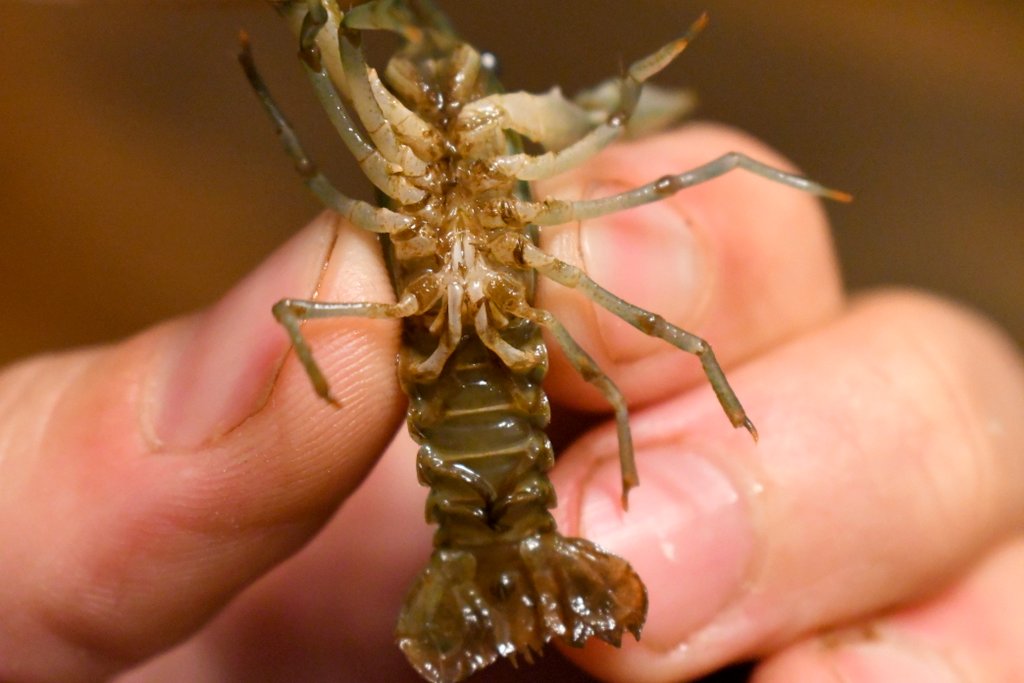Catching Ditch Crickets
A look at sexual dimorphism in crayfish
Before getting started this week, take the survey!! Inspired by Harvard’s Dialect Survey, I want to know what common name you have for the animal in the picture below (the survey is just one question). You can find results from the survey here. Then read on to find out more about the animal!

Northern clearwater crayfish, note the characteristic dark band on the back of the abdomen (Casavant Natural Area, Winooski)
I’ve heard that a crawdad you catch, a crawfish you eat, and a crayfish you study. Regardless of what you call these animals, they certainly merit more attention in Vermont than they currently get. I grew up in southern California and spent endless hours catching crawdads in the creek behind our house. It was always so thrilling to flip a rock and discover a pair of pinchers (technically cheliped) wagging ominously back at me. We’ve got crayfish here in Vermont as well, and for many years I overlooked them. When I started fishing, one of my friends told me I should be fishing with crawdads. I started flipping over rocks and was shocked by how many crawdads I found – about 10% of the rocks I flipped revealed a crawdad.
As I started catching more crawdads, a whole litany of questions came to mind. At the top of my list: What species was I catching? Initially, ID proved tricky. We’ve got almost 600 species of Vertebrates in Vermont, but only 8 or 9 crayfish, so I figured I’d have a much easier go at learning the crayfish. With the help of Jen Guarino (and her field guide to the crayfish of the White River Watershed) I first learned how to tell males from females, and then learned the key field marks for distinguishing between species. Rather than going into the species, I’ll first introduce you to the difference between males and females. October is, after all, breeding season for most of the species of crayfish in Vermont.

Ventral view of the gonopore of a female virile crayfish (Winooski River, Winooski)
Females
Most of the differences between male and female crayfish are relative differences: females are smaller overall, with smaller chelipeds (claws), wider tails, and larger swimmerets. Females also lack hooks on their 2nd pair of walking legs and have a single circular orifice at the base of the cephalothorax, called a gonopore. Mating occurs in the fall, but the eggs are not immediately fertilized. Instead, after mating with one or more males, the female will store the sperm through the winter in a spermatheca (source). When she releases the unfertilized eggs in the spring, she’ll simultaneously secrete a substance, called glair, that breaks down the sperm plug that has encased and protected the sperm throughout the long winter. The now fertilized eggs are held in place on her tail.
After hatching, the larvae also stay attached to her tail. Her wider tail and larger, stronger swimmerets help create a safe and secure environment for the young crayfish, protecting for the next few weeks before dispersing. But there’s always a risk that the young will get knocked free of their mother’s tail. Fortunately, adult females secret a hormone that larvae can detect. If displaced the larvae will swim back towards their mom.

Gonopods of a male northern clearwater crayfish (Salmon Hole, Burlington)

Gonopods of a male northern clearwater crayfish are bright white, the other pair just to the left are pleopods, called copulatory swimmerets; also visible are the hooks on the second pair of walking legs (Salmon Hole, Burlington)
Males
Males are larger, have narrower tails, and larger chelipeds (for fighting off other males and pinning females during mating). After hatching, both male and female larvae will molt 8-10 times as they grow. Shedding their exoskeleton allows them to get bigger with each molt. It also allows them to regenerate lost limbs. Crayfish typically mature in the second fall after hatching, after which females will molt only once per year, males twice. Males have what’s called cyclic dimorphism, where they take on different morphologies in their breeding (F1) and non-breeding (F2) forms. The difference is subtle, but necessary. Their mating form (F1) has a pair of spiny hooks on the second pair of walking legs that are used for clasping onto the female during mating. They also have gonopods, small legs adapted for depositing sperm. In the F1 form these become rigid and stronger. Males maintain this form for just a few weeks or months before reverting back to their non-breeding (F2) form.
A summary of the differences between males and females
| Feature | Male | Female |
|---|---|---|
| Tail | Narrow | Wide |
| Reproductive organ | Paired gonopods | Single gonopore |
| Chelipeds | Larger | Smaller |
| Hooks on 2nd set of walking legs | Present (on breeding adults) | Absent |
Oh, and if you do go out and find crayfish, please consider posting your observations to iNaturalist.org. I started a Crayfish Monitoring project to try and document the various species in the lower Winooski River watershed: Crayfish of Chittenden County.





